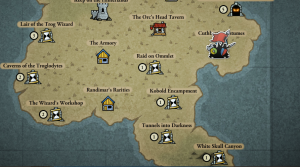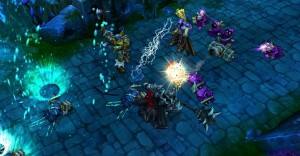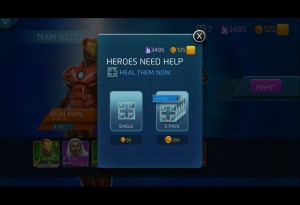After spending some time with Marvel’s Puzzle Quest, it is yet another example of a developer who thinks that the best use of microtransactions is forcing the player into spending money. When it comes to F2P design, the ultimate goal is to convert free users into paying customers, but the ways to do it without angering your consumer base are not easy.
Pay vs. Play:
When it comes to a F2P game, there are two areas as a designer you need to examine with your design: What elements are free and what will require a cost? Determining what parts are free can be difficult, as you want to give the player enough value to get them invested in the game.
Different F2P games have a different philosophy when it comes to their content. Some give the player a small taste of the game like ten levels of content, while others have main content that is free and additional content available to buy.
Making sure that the game has enough value without spending any money is tough. When we spoke with Joe Mcdonagh who helped design the F2P game Card Hunter, he talked about how long they racked their heads over how much of the game should be free. Eventually they decided on giving the entire campaign and multiplayer free.
Once you decided on what parts of your game are free, the next step is balancing the game so that the free content is entirely divorced from any micro transactions. Or in other words, if someone were to play your free content they should not at all be required to spend money on it.
The reasoning is simple, if the player feels at any time that they are being forced to spend money, it will throw the entire gameplay into question and drive the player away. As in: If one encounter was made to require the player to spend money, then who’s to say that there won’t be more like that?
Another thing to keep in mind is that there is a difference between saying that your content is free, but the game is restrictive to the point of frustrating without spending money.
World of Tanks before its freemium update became unbearable at the higher ranks unless you spent money. But of course they claimed that you could play through the entire the game without spending one cent.
Deciding how much you should give the player is a tough choice because at the end of the day you still need to be bringing money in or the game will tank. Now that we talked a little bit about the free part of your game, let’s move on to what you’re selling.
Adding it Up:
When it comes to any F2P game regardless of platform, genre or design, there are normally five different categories of microtransactions.
The first two are simple enough: Buying more in game currency, either the free kind or the premium. And by themselves, there is no ill intent or problem with these kinds of purchases. Maybe someone wants to get a leg up or cut down on finding resources. As long as they are reasonably priced, you can’t really screw up these purchases. But the same can’t be said for the remaining three.
The only consideration is that premium currency should be able to buy anything in the game that is available for purchase. If someone is spending real money then you don’t want them to feel like they wasted it on nothing.
Next are gameplay purchases: Anything that adds new content for the player to go through. For instance – a new raid, mission chain, quests, boss fight, etc. Anything that extends the amount of content and playtime in your game can be considered a gameplay purchase.
This is where pricing tends to vary as some developers just release a quest or two, while others may release an entire expansion. Lord of the Rings Online has numerous expansions and quest chains available to purchase, on top of their already lengthy base game.
Regardless of the pricing, there is one rule that you need to follow: Never ever, sell limited duration gameplay content. Once bought, any gameplay content must remain forever available to that account.
Buying gameplay content is a huge deal as it is the most substantial form of content and will keep the player invested in your game. Requiring the player to keep spending money to play it is akin to having to pump quarters in the arcades which died out about a decade ago.

Card Hunter gives an entire single player campaign and multiplayer for free, providing a lot of value to the consumer.
The next category is aesthetic purchases: new costumes, skins, special effects and so on. Anything that can personalize the character without directly affecting gameplay goes into this category.
Again, pricing is relative to the content that is available. Simply changing a character’s color from blue to red should not cost as much as an original costume.
What makes aesthetic purchases so fruitful is that the art team can go overboard and keep designing them, while none of them will ever impact balance or playing your game.
Riot Games with League of Legends’ profit structure is mostly based around aesthetic purchases. Premium costumes are the most expensive on their store and can cost (last time I checked) anywhere from $15 to $20 per costume. These costumes completely change the art asset for the character while sometimes having new sound effects as well.
Personalizing your character with aesthetic purchases usually comes after the player has become invested in your game. But in games with on screen avatars, aesthetic purchases can be the answer for how to make your game profitable without affecting gameplay.
Lastly we have quality of life purchases. These are purchases that are related to improving playing the game without adding new content. Increasing inventory, experience boosters, bypass levels and so on.
Quality of life purchases can be very lucrative as the people who have the money to burn, will like being able to speed up their progress or make things easier. However, quality of life purchases are normally the most intrusive to playing the game and depending on how bad they are, can sink a game.
Going back to World of Tanks before its update, leveling up crew members was a huge pain and your tank would respond poorly until you fought enough battles with that crew. Being able to spend money to quickly level everyone up was a way to bypass that time where you weren’t able to play optimally. But, you had to do this for every new tier and it became a constant cost of playing the game.
Quality of life purchases to me are the red flag for a game’s quality. If I’m being constantly bugged and prodded to spend money to make playing the game easier, then I am more likely to quit out of annoyance.
Simply put, if playing your game is so un-enjoyable that the option to skip playing it is a purchasable choice, you have greatly failed as a game designer.
The reason why quality of life purchases are so popular is that they are very easy to create. Just look at how someone plays your game and figure out ways to restrict them. There was of course the famous example of Star Wars: The Old Republic where free players were forbidden from running.
With all that said, the simple secret behind games like League of Legends, Card Hunter and Path of Exile use to make their micro transactions appealing is this: If the player at anytime feels like they are being forced to spend money, then the monetization has gone too far.
The old saying — “You can catch more flies with honey than vinegar” can be used here. The F2P games that are the most successful and build a loyal fan base are the ones that don’t pressure the consumers to spend money. Hell, you can play every kind of game mode in League of Legends and get access to every champion without spending one cent.
Now I know what some of you are thinking:” but isn’t gameplay content forcing the player to spend money?” It can be, but the best F2P games are the ones that have enough value that the player gets an enjoyable experience without spending money.
This goes back to what we talked about earlier, that the free portion of your game should be divorced from spending money. As if the player feels like they got enough value just by playing your game for free, then it will make buying gameplay content a lot easier.

League Of Legends was the first game that proved that F2P games could be massively successful and profitable.
And once someone spends money on your game, they will become invested in it and more likely to continuing spending on it.
You know you have a winner when people enjoy your game so much that they will spend money simply so they feel like they’re not taking advantage of your game.
F2P is currently viewed as a potential gold mine by developers wanting to cash in for a quick buck. Unfortunately, that makes it harder for developers who are trying to create long term F2P to stand out and above the rest. Another classic saying that fits: “One bad apple spoils the entire bunch.”
With the F2P boom that is going on, we may be heading towards a crash similar to the social game market. And hopefully the developers who are working on trying to elevate the F2P market won’t get caught in the crossfire.



